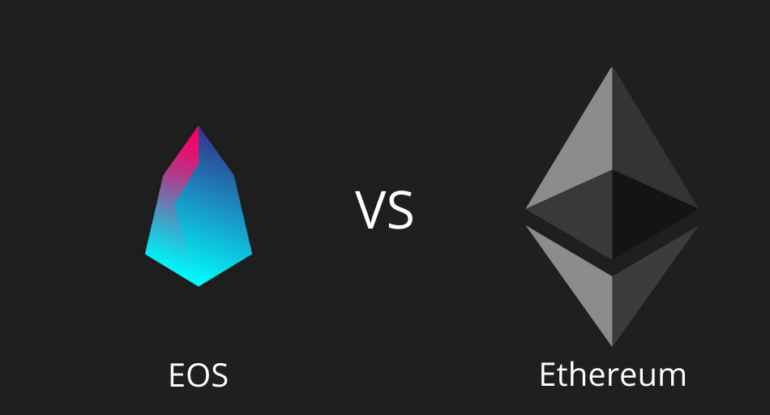EoS or Ethereum Which Is Faster, Better And Secure?

Ethereum and EOS are the world’s significant blockchain projects at this time. While Ethereum wants to decentralize world computing, EOS’s objective is to run fast decentralized applications. Each protocol uses a distinct consensus algorithm and a different governance model to accomplish these objectives.
Ethereum has a strong focus on decentralization at its crux, while EOS provides speed by eliminating some of its decentralized features.
Ethereum and EoS, based on their targets, have merits and demerits.
Ethereum is a decentralized smart contract platform. Like Bitcoin, the Ethereum network has a token known as Ether, a blockchain, nodes, and miners. Nonetheless, unlike Bitcoin, the blockchain maintains consensus for a ‘virtual computer’ dubbed the EVM, i.e., Ethereum Virtual Machine. Distributed smart contracts can be created and deployed on the EVM.
Ether is the native token on the Ethereum network. There is approximately 100 million Ether on the web today, and the token is used to incentivize miners to run their mining hardware.
The current inflation rate of Ether is approximately 10% a year, but the goal is to decrease this to 1-2% with future network upgrades. No hard cap is implanted on the Ether supply to date.
Ether tokens are used for payments between users like Bitcoin, but they can also be used to smart power contracts. When functioning a smart contract, the Ether is turned into gas to power a smart contract on the Ethereum Virtual Machine.
Consider this gas as the gasoline you put in your car – you need a different quantity of gas based on how small or long your journey is or depending on the type of road you are driving on. Smart contracts on the Ethereum Virtual Machine function is almost the same.
EOS
EOS is a blockchain architecture designed to facilitate vertical and horizontal scaling of decentralized applications by developing an operating system upon which applications can be built.
The software provides authentication, accounts, asynchronous communication, databases, and the scheduling of applications to many CPU cores.
The produced technology is a blockchain architecture that excludes user fees and provides quick and straightforward formation and maintenance of decentralized applications in the context of a governed blockchain.
EOS functions as a base-layer blockchain and as a smart contract platform. The protocol works like a decentralized operating system and allows for the deployment of industrial-scale applications through a decentralized self-governing corporation model. The smart contract platform claims to exclude transaction fees and also administer millions of transactions per second.
The chosen consensus algorithm is based on ‘Delegated Proof-of-Stake,’ i.e., those who possess tokens on the platform can select block producers through an extended approval voting system.
Anyone may choose to participate in block production and will be allowed to produce blocks, provided they can persuade token holders to vote for them.
The EOS consensus algorithm respects’ Byzantine Fault Tolerance’ by allowing producers to sign all blocks so long as no producer approves two blocks with a similar timestamp or the same block height. Once 15 producers have signed a block, the block is deemed irreversible.
Ethereum vs. EOS
When a crypto protocol aims at increasing scalability, either decentralization, security, or both will be adversely impacted. When a crypto protocol targets lower scalability, security, and decentralization increases. It is known as the scalability trilemma.
When a cryptocurrency project asserts they have solved scalability, make sure you observe the downside:
- Whether the project is centralized? Some of the examples are Bitcoin Cash, EOS, TRON, and NEO. All these cryptocurrencies can scale in regards to how fast the transactions process. Nonetheless, all are much more centralized than Ethereum or Bitcoin.
- Whether the blockchain is secure? When looking into security, one must always keep in mind there’s short-term and long-term security. Therefore, the question any investor should ask is: “If there’s an attack on the network, how can it be reversed?” If the answer is through a roll-back, distributing more coins, or any other solution that involves changes to the supply of coin ownership, the project cannot be secure because the blockchain isn’t immutable.
Comparing ETH and EOS, we can see that while Ethereum is slower but more secure, EOS is quicker but more centralized.
By comparing TPS and confirmation time, we immediately understand EOS was developed to relay transactions faster. By looking at the number of validating nodes and consensus protocol, we see Ethereum was built for security and decentralization.
Add a comment
You must be logged in to post a comment.




























































